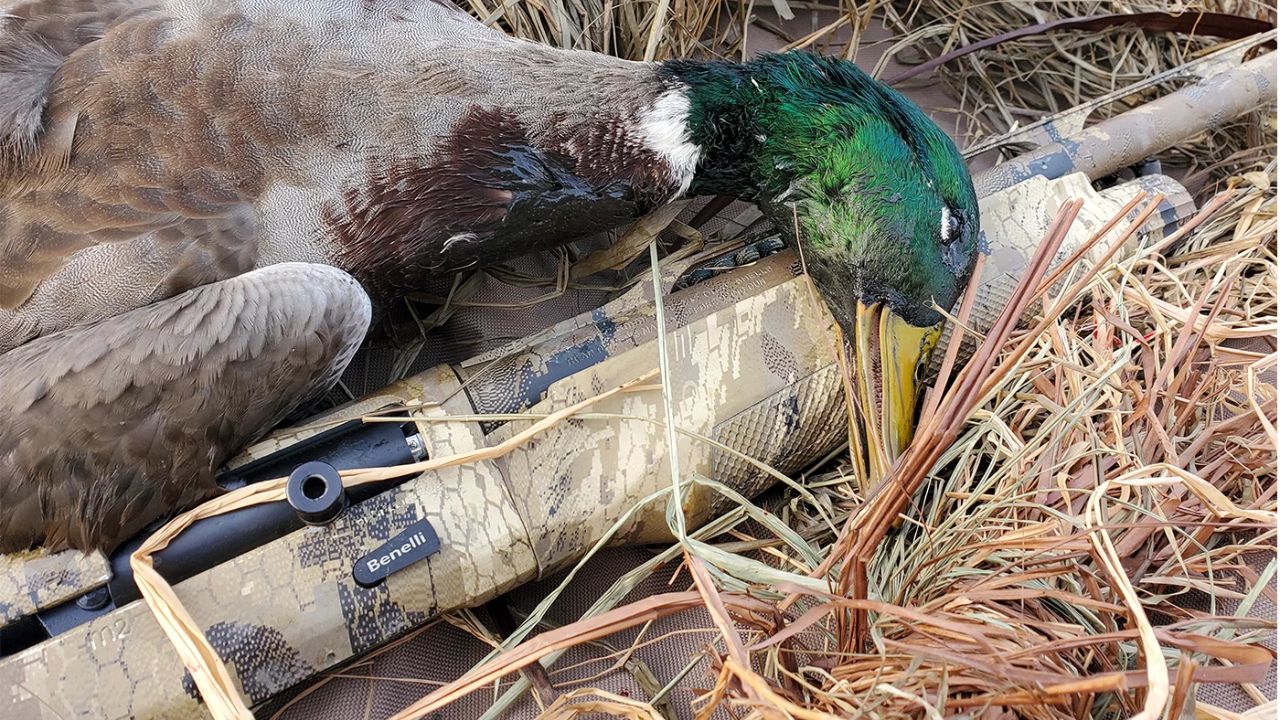This is “The Ultimate Guide to Choosing the Best Shot Size for Wood Ducks.” It is important to choose the proper shot size when passionate hunters set out on an exciting quest for wood ducks. We’ll get into the nuances of wood duck hunting in this extensive guide, covering gauge considerations, shotshell kinds, common shot sizes, shot selection variables, and safety precautions. This guide is intended to offer insightful information to improve your ability to make decisions and make hunting more ethical and successful, regardless of your level of experience. Come along on this journey with us as we explore the subtleties of selecting the ideal shot size for wood ducks.
Wood Ducks

Wood ducks, scientifically known as Aix sponsa, are enchanting waterfowl that grace North American wetlands with their vibrant plumage and unique behaviours. These striking birds, often considered the most colourful of all North American waterfowl, are recognized for their iridescent hues, intricate patterns, and distinct markings.
Characteristics of Wood Ducks:
Colouration: Male wood ducks boast stunning iridescence with vibrant greens, blues, and reds, while females display more subdued brown and grey tones.
Distinctive Features: Both genders exhibit crested head feathers and distinctive eye markings, contributing to their unmistakable appearance.
Habitat: Best shot size for wood ducks prefer wooded wetlands, swamps, and shallow ponds for breeding and nesting. They are equally adaptable to both freshwater and brackish environments.
Behaviour: Known for their perching abilities, The Best Waders For Short Fat Guys wood ducks often roost in trees, displaying an unusual behaviour among waterfowl. They are agile flyers and skilled at navigating dense vegetation.
Wood Duck Hunting:
Seasons and Regulations: The best shot size for duck hunting is subject to specific seasons and regulations. Hunters must adhere to legal frameworks governing the time, location, and permissible methods for hunting.
Importance of Shot Size: Selecting the right shot size is critical for effective and ethical hunting. Factors such as distance, shot penetration, gauge, and environmental conditions influence the choice of shot size.
Conservation Status:
Conservation Efforts: While wood duck populations have rebounded, conservation efforts have played a crucial role. Nesting boxes, wetland preservation, and habitat conservation contribute to sustaining wood duck populations.
Migratory Patterns: Wood ducks exhibit migratory patterns, with some populations undertaking extensive journeys between breeding and wintering grounds. Understanding these patterns aids in effective conservation strategies.
Wood ducks captivate both wildlife enthusiasts and hunters alike, showcasing the intricate balance between vibrant aesthetics and fascinating behaviours in the diverse ecosystems they inhabit. Whether observed for their beauty or pursued for sport, wood ducks contribute to the rich tapestry of North America’s wetland environments.
What shot size for ducks 12-gauge
Selecting the right shot size for ducks when using a 12-gauge shotgun is crucial for effective and ethical hunting. The appropriate shot size depends on various factors, including the type of ducks you’re targeting, shooting conditions, and personal preferences. Here are some commonly recommended shot sizes for 12-gauge shotguns when hunting ducks:
Steel Shot (Non-Toxic):
- #2 Shot: Ideal for larger ducks at moderate ranges.
- #3 Shot: Versatile option suitable for a variety of duck species.
- #4 Shot: Effective for decoying ducks or when a tighter pattern is desired.
Bismuth Shot (Non-Toxic Alternative):
- #4 Shot: Suitable for a range of duck species, providing effective performance.
Tungsten Shot (Non-Toxic Premium Option):
- #2 or #3 Shot: Offers high density for increased lethality and longer effective ranges.
Lead Shot (where legal):
- #4 or #6 Shot: Effective for decoying ducks and close-range shots.
It’s essential to check and comply with local regulations, as many areas require the use of non-toxic shots for waterfowl hunting. Additionally, consider the specific conditions of your hunting environment, the size of the waterfowl shot size chart you’re targeting, and your shooting proficiency when making your shot size selection. Prioritize safety and moral hunting techniques at all times when engaging in this outdoor activity.
Factors Influencing Shot Size

Several factors influence the choice of shot size when hunting ducks, and understanding these variables is crucial for effective and ethical shooting. Here are key factors to consider:
Duck Species:
Different duck species vary in size and resilience. Tailor your shot size based on the specific species you are targeting.
Distance from the Target:
The distance between you and the ducks is a critical factor. Larger shot sizes may be suitable for longer ranges, while smaller shot sizes are more effective at close distances.
Shot Penetration and Effectiveness:
Consider the shot’s penetration power. Larger shot sizes penetrate more deeply, while smaller shot sizes may be preferable for creating denser patterns at shorter ranges.
Gauge Considerations:
The gauge of your Shotgun influences the shot size selection. A 12-gauge shotgun, for example, can accommodate a range of shot sizes, offering versatility in different hunting scenarios.
Environmental Conditions:
Weather conditions, including wind and rain, can impact shot performance. Heavier shot sizes may be more resistant to wind, while lighter shot sizes may be affected.
Legal Restrictions:
Local regulations often dictate the type of shot size permitted for waterfowl hunting. Ensure compliance with legal requirements to promote ethical and responsible hunting practices.
Personal Preferences and Shooting Proficiency:
Consider your personal shooting preferences and proficiency. Some hunters may prefer larger shot sizes for increased impact, while others may opt for smaller shot sizes for a denser pattern.
Understanding these factors allows hunters to make informed decisions when selecting shot sizes, optimizing the chances of a clean and humane harvest while adhering to ethical and legal hunting practices.
Common Shot Sizes for Wood Ducks
When best all around shot size for ducks and geese, selecting the right shot size is crucial for effective and ethical shooting. Common shot sizes for wood ducks vary based on factors like distance, gauge, and personal preference. Here are some widely used shot sizes for wood duck hunting:
Steel Shot (Non-Toxic):
- #2 Shot: Suitable for larger wood ducks at moderate ranges.
- #3 Shot: Versatile option effective for various wood duck species.
- #4 Shot: Ideal for decoying wood ducks or when a tighter shot pattern is desired.
Bismuth Shot (Non-Toxic Alternative):
- #4 Shot: Effective for wood ducks, providing a balance between pellet count and shot size.
Tungsten Shot (Non-Toxic Premium Option):
- #2 or #3 Shot: Offers high density for increased lethality and longer effective ranges, making it suitable for wood ducks.
Lead Shot (where legal):
- #4 or #6 Shot: This shot is Effective for decoying wood ducks and close-range shots, providing a good compromise between pellet count and size.
When choosing shot sizes, consider the specific wood duck species in your area, the shooting conditions, and your shooting proficiency. Always adhere to local regulations regarding non-toxic shot requirements for waterfowl hunting. By making informed choices, The Ultimate Guide To Choosing Best Binoculars For Duck Hunting you can enhance the effectiveness of your shots while promoting ethical and responsible hunting practices.
Gauge Selection

Gauge selection is a crucial aspect of preparing for wood duck hunting, influencing both the effectiveness and comfort of your shooting experience. Here’s a closer look at considerations for gauge selection:
Factors Influencing Gauge Choice:
- Consider the wood duck species targeted and their typical habitats.
- Evaluate personal preferences regarding recoil tolerance and firearm weight.
12-Gauge Shotgun:
- Versatile and widely used for wood duck hunting.
- Accommodates a range of shot sizes suitable for various wood duck scenarios.
- Well-suited for both close-range decoyed shots and longer shots.
20-Gauge Shotgun:
- Provides a lighter and more maneuverable option.
- Suitable for hunters who prioritize reduced recoil without sacrificing significant performance.
- Effective for wood duck hunting at moderate distances.
28-Gauge and .410 Bore:
- Generally less common for waterfowl hunting.
- Suitable for hunters seeking a lighter shotgun with reduced recoil.
- It may have limitations on shot payload, affecting effective range.
Personal Comfort and Proficiency:
- Choose a gauge that aligns with your comfort level in handling and shooting.
- Consider your proficiency with the selected gauge to ensure accurate and ethical shots.
Versatility for Other Game:
- Evaluate whether the chosen gauge serves multiple purposes, accommodating other game species.
- A versatile shotgun can be advantageous for different hunting scenarios.
Ultimately, the ideal gauge selection for wood duck hunting depends on individual preferences, hunting conditions, and the desired balance between power and comfort. Prioritize safety, accuracy, and personal comfort to optimize your experience during bb vs 2 shot for geese outings.
Shotshell Types
Choosing the right shotshell type is integral to a successful wood duck hunting experience. Different shotshell materials offer varying performance characteristics, influencing factors such as pattern density, penetration, and environmental impact. Here’s an overview of shotshell types for shot size for wood ducks:
Steel Shot (Non-Toxic):
Advantages:
- Required in many areas to comply with non-toxic shot regulations.
- Suitable for effective hunting without environmental concerns.
Considerations:
- Lower density than lead may require larger shot sizes for similar effectiveness.
Bismuth Shot (Non-Toxic Alternative):
Advantages:
- Environmentally friendly and effective.
- Similar density to lead, PIÈGES OUELL – 411 offering good performance without toxic concerns.
Considerations:
- Higher cost compared to steel shot.
Tungsten Shot (Non-Toxic Premium Option):
Advantages:
- Superior density and energy retention, providing excellent lethality.
- Environmentally friendly and complies with non-toxic shot regulations.
Considerations:
- Higher cost but offers premium performance.
Lead Shot (where legal):
Advantages:
- Traditional option with excellent lethality.
- Affordable and widely available.
Considerations:
- Restricted in some places because of environmental issues.
- Requires careful disposal to prevent lead contamination.
Shotshell Sizes and Configurations:
- Varying shotshell sizes (#2, #3, #4) and configurations (shells, loads) provide adaptability.
- Consider the specific wood duck species, hunting conditions, and regulations when choosing shotshells.
Understanding shotshell types and their characteristics allows hunters to make informed decisions, balancing effectiveness with environmental considerations. Always comply with local regulations regarding non-toxic shot requirements and choose shotshells that align with ethical and responsible hunting practices.
Shot Placement Tips
Shot placement is a critical aspect of ethical and effective wood duck hunting. Proper shot placement ensures a humane harvest and minimizes the risk of lost or wounded birds. Consider the following tips for accurate and responsible shot placement:
Aim for Vital Areas:
- Target vital areas such as the head, neck, or upper body.
- Strive for clean and ethical kills to minimize suffering.
Decoying Shots:
- When wood ducks are decoying, aim for the head or neck for a precise and effective shot.
- Avoid shots directly at the water, Mastering Your Shots: The Science Of The Beretta A400 Xtreme Plus Chokes as pellets may skip off the surface.
Passing Shots:
- For passing shots, aim slightly in front of the bird’s bill to account for its forward movement.
- Target the upper body, focusing on vital areas to ensure a swift and humane harvest.
Avoid Shooting Low:
- Avoid shooting low and directly at the water’s surface to prevent pellets from skipping and potentially injuring the bird without a clean kill.
Wait for Clear Shots:
- Exercise patience and wait for clear and ethical shots.
- Avoid shooting into dense vegetation where visibility is compromised.
Adapt to Shooting Conditions:
- Consider the lighting conditions and adjust your aim accordingly.
- In low-light situations, focus on easily visible areas like the silhouette of the head and neck.
Practice and Proficiency:
- Regularly practice shooting to enhance proficiency and accuracy.
- Familiarity with your Shotgun’s pattern at different distances contributes to effective shot placement.
Mind Your Surroundings:
- Be mindful of the surroundings and ensure a safe backdrop for shots.
- Avoid shooting when other hunters or obstacles are nearby.
Respect Hunting Regulations:
- Familiarize yourself with local hunting regulations regarding legal shooting hours and any restrictions on shooting over water.
Prioritize Safety:
- Always prioritize safety by following the basic principles of firearm safety.
- Keep an eye on your surroundings and the whereabouts of other nearby hunters.
By incorporating these shot placement tips into your wood duck hunting strategy, you can enhance your effectiveness as a hunter while adhering to ethical and responsible practices in the field.
Safety Considerations
Safety considerations are paramount in wood duck hunting, ensuring a responsible and secure experience for hunters and those in their vicinity. Follow these key safety guidelines for a safe and enjoyable wood duck hunting outing:
Know and Follow Hunting Regulations:
- Familiarize yourself with local, state, and federal hunting regulations.
- Adhere to specific rules and seasons governing wood duck hunting.
Firearm Safety:
- Handle all firearms as though they were loaded.
- Make sure the muzzle is always pointed in a safe direction and away from you and other persons.
- Keep the firearm’s safety engaged until ready to shoot.
Identify Your Target:
- Identify your target before taking a shot.
- Be certain of the species and sex of the wood duck to avoid unintentional harm.
Control the Muzzle:
- Control the direction of the firearm’s muzzle, especially when loading, unloading, or moving.
- Avoid swinging the muzzle toward others in the hunting party.
Use Hunter Orange:
- Wear hunter orange to enhance visibility and identification.
- Make sure to follow any legal requirements regarding hunter-orange clothing.
Communication:
- Establish clear communication with other hunters in the vicinity.
- Use verbal signals or agreed-upon signs to indicate movements and intentions.
Be Mindful of Water Hazards:
- Be cautious around water bodies, especially in challenging conditions.
- Use flotation devices when hunting from boats or in areas with deep water.
Know Your Surroundings:
- Keep an eye on your surroundings and other hunters’ whereabouts.
- Steer clear of roads, buildings, REAL GEESE WOOD STAKE (SPARE-LONG) 1DZ and other populated places when shooting.
Weather Considerations:
- Pay attention to weather conditions that may affect safety, such as strong winds or storms.
- Exercise caution when handling firearms in adverse weather.
First Aid and Emergency Preparedness:
- Carry a basic first aid kit and know how to use it.
- Be prepared for emergencies by informing someone of your hunting plans and expected return time.
By prioritizing safety considerations, wood duck hunters can minimize the possibility of mishaps and injuries while promoting a culture of ethical and careful hunting. Remain knowledgeable at all times, handle firearms safely, and encourage a feeling of collective responsibility among hunters.
Conclusion
In conclusion, the pursuit of wood duck hunting is not just a seasonal activity; it’s a continuous journey of learning, adaptation, and appreciation for the rich tapestry of nature. By understanding the nuances of wood duck behaviour, making informed choices about shot size, gauge selection, and shotshell types, and prioritizing safety and ethical practices, hunters can elevate their experiences in the field.
As each hunting expedition unfolds, the reflections on shots taken, strategies employed, and lessons learned contribute to a hunter’s growth and proficiency. The ability to adapt to different environmental conditions, refine hunting tactics, and collaborate with fellow enthusiasts fosters a sense of camaraderie within the hunting community.
Wood duck hunting is not merely about the harvest; it’s a holistic experience that connects individuals with the outdoors, wildlife, and hunting’s heritage. Through responsible practices, continual learning, and a deep respect for the environment, hunters contribute to the conservation of species and the preservation of hunting traditions.
As you embark on future wood duck hunting adventures, may your experiences be rich with moments of connection, observation, and success. Cherish the memories made in blind people, the echoes of calls on the water, and the lessons drawn from each encounter with these magnificent waterfowl. May your Shotgun always be true, your aim steady, and your appreciation for the beauty of nature unwavering. Happy hunting!

